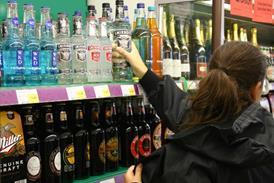- Home
- Retail & Wholesale
-
Products & Suppliers
- Back to parent navigation item
- Products & Suppliers
-
Product Categories:
- Back to parent navigation item
- Product Categories:
- Alcoholic drinks
- Bakery
- Cereals & breakfast
- Cheese
- Chicken & poultry
- Chocolate
- Confectionery
- Crisps, nuts & snacks
- Dairy
- Fish
- Fresh produce
- Frozen
- Household
- Meat
- Own Label
- Sauces & condiments
- Seasonal
- Soft drinks
- Vaping
- Vegan & plant-based
- World foods
- Suppliers
- People
- Reports & Data
-
Topics A-Z
- Back to parent navigation item
- Topics A-Z
-
Popular topics:
- Back to parent navigation item
- Popular topics:
- Cost of living crisis
- Crime
- Deposit Return Schemes
- Finance
- Government & Regulation
- Health
- Inflation
- Loyalty
- Marketing
- Mergers & Acquisitions
- New Product Development
- Sourcing
- Supply chain
- Sustainability & environment
- Technology
- Ultra Processed Foods
- Vaping
- A-Z all topics
- Content by type:
- Events
- Ask iA (beta)
- Subscribe now
- Previous slide
- 2 of 3
- Next slide
| What consumers think of butter | |||||
|---|---|---|---|---|---|
| 15% | Buy butter once a week or more | ||||
| 11% | Never buy butter | ||||
| 84% | Use butter for toast | ||||
| 61% | Use butter for cooking | ||||
| 65% | Like the flavour of butter | ||||
| 29% | Think prices have gone up too much | ||||
| Source: Harris Interactive poll of 2,103 consumers, May 2018 | |||||
There are regional variations when it comes to butter consumption. Butter is most popular in Wales, where 21% of consumers buy it at least once a week and only 6% abstain from buying it completely. By contrast, only 11% of those in the south east buy it weekly and 14% never make a purchase.
Shoppers in the north west were most conscious of their purse strings, with 33% saying the price of butter had gone up too much recently, compared with 23% of Londoners.
Age also played a part in butter consumption, as younger shoppers perceived it as unhealthier. A quarter of 18 to 24-year-olds said butter was an unhealthy source of fat, compared with just 16% of consumers aged over 55.
Younger generations are more inclined to try butter alternatives. Margarine is prized most by the 25 to 34 age group, 15% of whom said they preferred it to butter, while only 8% of 45 to 54-year-olds were fans. A not insignificant 12% of 18 to 24-year-olds said they would choose dairy-free spreads over butter, compared with just 5% of the over-55s.
Taste was the most important draw for butter. Overall, 65% of consumers said they liked the taste and only 3% actively disliked it. However, this also provoked a generational split. Only 52% of 18 to 24 year-olds agreed butter had a good flavour, compared with 71% of the over 55s.
Toast remains the most common reason for using butter. But a large proportion of younger consumers are getting into home baking, with as many as 25 to 34-year-olds using butter for that purpose compared with just 49% of over-55s. The older generation were more likely to spread butter on crackers (57% of over-55s).
Consumers in the south east are more likely to use butter for cooking. As many as 67% of Londoners cook with butter and 65% in the South East, compared with 55% in the Midlands.Source: Harris Interactive poll of 2,103 consumers, May 201815%
| Value (£m) | % y-o-y | |
|---|---|---|
| Spreadable | 498.7 | 12.9 |
| Block | 395.1 | 28.4 |
| Dairy Spreads | 198.8 | -1.7 |
| Specific Health | 84.2 | 0.2 |
| Olive Spreads | 60.4 | -1.3 |
| Margarine | 53.6 | 0.8 |
| Low Fat | 52.6 | 0.6 |
| Sunflower | 33.6 | 5.2 |
| White Fat | 28.2 | -3.2 |
| Flavoured & Alcoholic | 6.5 | -3.8 |
| Branded | 1411.6 | 4.7 |
| Own label | 912.9 | 33.1 |
| Source: Kantar Worldpanel, 52 w/e 25 February, 2018 |
Both spreadable and block butters are seeing double-digit value increases. An extra £141m was spent on the category this year, almost entirely down to price inflation.
The price rises were fuelled by a decline in promotions, which has seen shoppers trade down from expensive block butter to spreadable butter and dairy spreads.
Shoppers are still looking for deals when they can get them. Just over 40% of BSM was bought on promotion last year, with the majority coming from cut-price deals as retailers move away from volume-based deals.
Spreads with health credentials, such as free-from and sunflower spreads, is the only sub-category in volume growth.
Brands continue to dominate with a 73% share of the category. However, own label is advancing, adding 33.5% value and 5.1% to volume sales.
Annabelle Gough, Kantar WorldpanelBrands vs own labelSource: Kantar Worldpanel 52 w/e 25 February 2018
| Top 10 butter and spreads brands | |||
|---|---|---|---|
| Value (m) | % change yoy | ||
| Lurpak | 327.6 | 9.7 | |
| Own label | 236.7 | 27.4 | |
| Anchor | 114.5 | 21 | |
| Flora | 84.7 | -1 | |
| Clover | 69 | 4.8 | |
| Country Life | 51.2 | -9.6 | |
| Bertolli | 37.9 | -2.4 | |
| Flora Proactiv | 33 | -8.5 | |
| Stork | 27 | -5.5 | |
| Kerrygold | 26.2 | 9.6 | |
| Source: Nielsen, 52 w/e 21 April 2018 | |||
Most brands experienced a decrease in volume and increase in value sales due to inflation, which was driven by a global butterfat shortage that plateaued in the last quarter.
One brand bucking the trend was Anchor, which benefited from a pragmatic approach to pricing that helped fuel positive volume growth (9.2%) in both block and spreadable sectors.
Own label made massive strides in the market, growing value at a rate of 27.4% year on year despite a small dip in volume (-1.8%).
Bertolli managed to hold on to its volumes despite the launch and demise of its Sensations Lemon and Chilli-infused butter SKU last year. However, value sales were down 2.4%.
Rupert Austin, Nielsen client business partnerSource: Nielsen 52 w/e 21 April 2018






